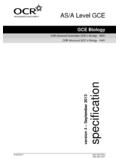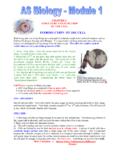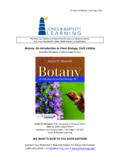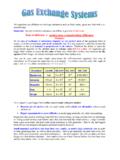Transcription of Physical and Chemical Properties of Water - VDOE
1 Science Enhanced Scope and Sequence Biology Virginia Department of Education 2012 1 Physical and Chemical Properties of Water Strand Life at the Molecular and Cellular Level Topic Understanding Physical and Chemical Properties of Water Primary SOL The student will investigate and understand the Chemical and biochemical principles essential for life. Key concepts include a) Water chemistry and its impact on life processes. Related SOL The student will demonstrate an understanding of scientific reasoning, logic, and the nature of science by planning and conducting investigations in which a) observations of living organisms are recorded in the lab and in the field; i) appropriate technology, including computers, graphing calculators, and probeware, is used for gathering and analyzing data, communicating results, modeling concepts, and simulating experimental conditions; l) alternative scientific explanations and models are recognized and analyzed.
2 Background Information On this planet, Water is the only substance that occurs abundantly in all three Physical states. It is our only common liquid and is our most widely distributed pure solid, ever present somewhere in the atmosphere as suspended ice particles or on Earth s surface as various types of snow and ice. It is essential to life as a stabilizer of body temperature, as a carrier of nutrients and waste products, as a reactant and reaction medium, as a stabilizer of biopolymer conformation, as a likely facilitator of the dynamic behavior of macromolecules, including their catalytic (enzymic) Properties , and, perhaps, in other ways yet unknown. Water is so essential for life that when we look for indications of life extraterrestrially, we typically look first for Water or signs of Water . The suitability of a habitat for life here on Earth, or extraterrestrially, depends in large part on the Chemical and Physical Properties of Water .
3 These unique Properties are due to the nature of the polar and hydrogen bonding between and within the Water molecules. Materials Construction paper Hole-punches Drinking glasses Deionized Water Pennies or nails Shallow bowls Pepper Sugar cubes Dish detergent Pipettes Capillary tubes or straws of different sizes Science Enhanced Scope and Sequence Biology Virginia Department of Education 2012 2 Metric rulers Sand Scales Beakers of the same size Thermometers Hot Water Ice Water Beakers or test tubes Vinegar Ammonia Freshly squeezed lemon juice (citric acid) Milk pH meter/probe or pH paper Stir rods Water samples taken from various sources ( , tap, well, pond, stream, lake) Calorimeters (optional) Physical and Chemical Properties of Water handout (attached) Vocabulary adhesion, capillary action, cohesion, conductivity, electron, hydrogen bond, pH, polar bond, specific heat, surface tension Student/Teacher Actions (what students and teachers should be doing to facilitate learning) There are several activities in this lesson.
4 If there is not enough time for every lab group to do every activity, you may wish to have groups do different activities and then share data. 1. As an introductory stimulus, read aloud the following selection, Prologue Water : The Deceptive Matter of Life and Death 1 Unnoticed in the darkness of a subterranean cavern, a Water droplet trickles slowly down a stalactite, following a path left by countless predecessors, imparting as did they, a small but almost magical touch of mineral beauty. Pausing at the tip, the droplet grows slowly to full size, then plunges quickly to the cavern floor, as if anxious to perform other tasks or to assume different forms. For Water , the possibilities are countless. Some droplets assume roles of quiet beauty on a child s coat sleeve, where a snowflake of unique design and exquisite perfection lies unnoticed, on a spider s web, where dew drops burst into sudden brilliance at the first touch of the morning sun, in the countryside, where a summer shower brings refreshment, or in the city, where fog gently permeates the night air, subduing harsh sounds with a glaze of tranquility.
5 Others lend themselves to the noise and vigor of a waterfall, to the overwhelming immensity of a glacier, to the ominous nature of an impending storm, or to the persuasiveness of a tear on a woman s cheek. For others the role is less obvious but far more critical. There is life initiated and sustained by Water in a myriad subtle and poorly understood way or death inevitable, catalyzed under special circumstances by a few hostile crystals of ice, or decay at the forest s floor, where Water works relentlessly to disassemble the past so life can begin anew. But the form of Water most familiar is none of these; rather it is simple, ordinary, and uninspiring, unworthy of special notice as it flows forth in cool abundance from a household tap.
6 : 1 Owen R. Fennema, Prologue Water : The Deceptive Matter of Life and Death, Water and Ice, Food Chemistry (1985): 24. Science Enhanced Scope and Sequence Biology Virginia Department of Education 2012 3 Humdrum, galunks a frog in concurrence, or so it seems, as it views with stony indifference the Water milieu on which its very life depends. Surely, then, Water s most remarkable feature is deception, for it is in reality a substance of infinite complexity, of great and unassessable importance, and one endowed with a strangeness and beauty sufficient to excite and challenge anyone making its acquaintance. 2. Discuss the many forms of Water mentioned in the selection or that students have encountered in their lives.
7 3. Have students create models of a Water molecule, using simple cutouts from construction paper, as follows: Cut out one large circle for the oxygen atom, two smaller circles for the hydrogen atoms, and several hole-punch dots for electrons. Guide students in arranging their cutouts to illustrate that in a polar bond, the negatively charged electrons shared between oxygen and hydrogen are closer to the oxygen atom, making the oxygen atom slightly negative and the hydrogen atom slightly positive. Show students how a hydrogen bond could form between the oxygen atom of one Water molecule and a hydrogen atom of another. 4. Ask students to consider why Water is different from other liquids, and what it is about hydrogen bonding that makes Water behave the way it does. Also ask why, when we explore other planets, one of the first substances we look for is Water .
8 Introduce the Properties of Water that make it unique as a result of its polarity. 5. Have students complete the differentiated activities found on the attached Physical and Chemical Properties of Water handout. Alternatively, assign each group one of the five activities to complete, and have groups share their experiments, observations, and explanations of results with the class. Assessment Questions o How are ionic and covalent bonds relevant to the suitability of Water as a medium for living systems? Explain. Journal/Writing Prompts o Given three specific heat values, discuss the relevancy of the values and their relationship to those of others liquids to the suitability of Water as a medium for living systems. o Three living arrangements are described below. For each one, state which bond hydrogen, polar covalent, or nonpolar covalent it illustrates, and explain why.
9 - Ms. Scarlett and Mr. Green purchase a home together. They split the cost 50-50. (nonpolar covalent) - Professor Plum and Colonel Mustard buy a condo. Plum lives in the condo for eight months of the year, and then Mustard lives there for the other four months. (polar covalent) - Ms. White and Ms. Peacock live next door to each other and are always visiting each other s apartments. (hydrogen) Other o Have students write thank-you notes to Water , specifically addressing its four Properties . Notes should include writing (prose, poem, or song lyrics) as well as graphics. Science Enhanced Scope and Sequence Biology Virginia Department of Education 2012 4 o Tug of War: Create a game board by drawing a pond/river in the middle of a sheet of paper. Make one copy for each group. Create tug of war ropes by tying ten equidistant knots in a piece of string.
10 Divide students into groups, and give each group a piece of knotted string. Have the groups subdivide into two teams and place their string on the game board so that it is evenly spread across the Water . One team poses a review question. If the other team answers correctly, the string moves one knot in their direction, thus moving their opponent closer to the Water . If they are incorrect, the string moves in the other direction. Game ends when one team gets pulled into the Water . o Word Puzzles: Display the following on the board: - p b = s p and s n - n p b = e s of e - h b = w a b p m Challenge students to hypothesize the meaning behind the letters: - p b = s p and s n (polar bond = slightly positive and slightly negative) - n p b = e s of e (non polar bond = equal sharing of electrons) - h b = w a b p m (hydrogen bond = weak attraction between polar molecules) (Word Puzzles like this can be used as a pre- or post-activity for any vocabulary in any lesson.)















